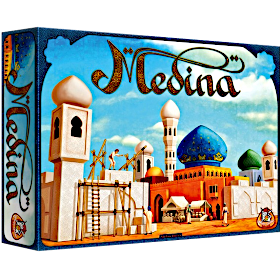메디나
 1822년, 아틀라스 산맥 밑자락에 있는 메디나를 재건할 시간이 수년 간의 쇠퇴기 이후에 마침내 다가왔습니다. 도시의 건축가와 기술자들은 크고 아름다운 궁전을 지으면서 무너진 벽을 보수하는 작업에 들어갑니다. 오랜 도시의 재건이 진행됨에 따라 거리에 주민들이 모여들어 새로운 도시의 윤곽이 잡히기 시작합니다!
1822년, 아틀라스 산맥 밑자락에 있는 메디나를 재건할 시간이 수년 간의 쇠퇴기 이후에 마침내 다가왔습니다. 도시의 건축가와 기술자들은 크고 아름다운 궁전을 지으면서 무너진 벽을 보수하는 작업에 들어갑니다. 오랜 도시의 재건이 진행됨에 따라 거리에 주민들이 모여들어 새로운 도시의 윤곽이 잡히기 시작합니다!
플레이어는 차례마다 (차 타일로 차례를 넘기지 않는다면) 게임판에 말 2개를 교대로 놓으면서 (새로 건물을 짓는 경우 외에는) 이미 있는 건물을 키우거나 시장 또는 벽 같은 도시의 다른 부분을 확장합니다. 각 플레이어는 게임이 끝날 때까지 4가지 색깔의 건물을 하나씩 소유하게 되며, 소유한 건물의 나무 말마다 1점씩을 받습니다.
그리고 한 색깔에서 가장 큰 궁전을 소유하면 그 색깔의 추가 점수를 받습니다. 마지막으로, 가장 최근에 도시의 꼭지점 4곳에 있는 벽들 중 하나에 이어지는 건물을 완성한 플레이어는 그에 따른 추가 점수를 받습니다.
플레이어 수: 2 - 4
게임 시간: 46 mn
복잡성: 2 / 5
메디나 및 다른 게임 959개를 온라인으로 즐겨보세요.
다운로드가 필요없으며, 웹 브라우저에서 바로 플레이할 수 있습니다.
친구들과 그리고 전세계의 수많은 게이머들과.
무료.

메디나 및 다른 게임 959개를 온라인으로 즐겨보세요.
다운로드가 필요없으며, 웹 브라우저에서 바로 플레이할 수 있습니다.
친구들과 그리고 전세계의 수많은 게이머들과.
무료.

규칙 요약
Introduction
- In Medina, players must place two pieces on the board (except when allowed to skip this with a tea tile), by either:
- Augmenting an existing building
- Or starting a new building if the current building of that colour is finished, or
- Expanding one of the other features of the city, like the market or the walls.
- Augmenting an existing building
- Each player will claim one building of each of the four colours by the end of the game, giving one point per wooden piece attached to the building.
- Also, if you own the largest building of a particular colour you get a bonus for that colour.
- Finally, there are bonuses for palaces around the well, as well as for the player who most recently connected one of their buildings to the walls, which grow from the four corners of the city.
Setup
- Depending on edition selected and players number, each player receives a number of blocks that they will place on the board in turn:
| Block | 2 players | 3 players | 4 players |
|---|---|---|---|
| Buildings | 8 | 6 | 5 |
| Rooftops | 4 | 4 | 4 |
| Neutral rooftops | 2 (if applicable) | 1 (if applicable) | 0 |
| Stables | 4 | 4 | 3 |
| Merchants | 12 | 8 | 6 |
| Walls | 15 | 12 | 9 |
- A merchant is placed randomly on the board as well as a well if applicable.
- A first player is randomly chosen.
Game options
- The following options can be selected or deselected prior to a game:
Fountain
- If this option is activated, a well will be created on a random field on the game board before the start of the game.
- For each part of the palace that is directly orthogonally adjacent to the fountain, there are 4 additional points.
- The fields for which there are 4 points each are marked in blue on the game board.
Tea tiles
- If this option is activated, there are 6 purple tea tiles in the game.
- If you take possession of the first purple palace, you receive 3 tea tiles.
- The player who takes possession of the second purple palace receives 2 tea tiles.
- And the third player receives 1 tea tile. If a player owns tea tiles, they can take tea breaks.
- They then only have to build a piece of wood in their turn and can then, instead of playing another piece of wood, give a tea tile.
Merchants on the tower tiles
- When this option is activated, 6 additional merchants come into game.
- There are 3 merchants on the 1 tower tile, 2 merchants on the 2 tower tile and 1 merchant on the 3 tower tile.
- The player who wins such a tower tile first receives additional 1, 2 or 3 merchants.
Neutral rooftops
- If this option is activated in the game with three people, each player also receives a neutral grey roof.
- If a neutral, grey roof is placed on a palace, this palace does not belong to any player.
- In a two-player game, each player always receives 2 neutral roofs.
- In a game for two, the neutral roofs cannot be deactivated.
- The first edition of Medina could only be played by three or four players.
- With the neutral roofs, the game on a slightly smaller game board also works very well for two.
- In a four-player game, the neutral roofs are not available.
Blocks
Buildings
- These are the blocks received in the largest quantity.
- They come in four colours:
- white, purple, maroon, orange.
- Adjacent buildings constitutes palaces, which grow in time.
- A building can be placed only adjacent orthogonally to an unfinished palace of this colour or anywhere on the board if no palace of this colour is unfinished.
- Buildings cannot be placed adjacent orthogonally or diagonally to another palace, meaning there is always room for an alley between two palaces.
Rooftops
- Rooftops are used to claim palaces.
- A player can only claim one palace of a given colour.
- Once they have placed a rooftop on a palace, this palace is finished and cannot be expanded further by buildings.
- Also, if a player claims the largest palace they will get the palace tile of this colour for additional points.
- Palace tiles can change hands several times.
- In 2nd edition game, players will also receive neutral rooftops used to finish palaces and thwart opponents plans.
- Palace tiles can be claimed by the "neutral" player and be placed back onto the board.
Stables
- Stables can be used only to expand existing palaces.
- They must be placed orthogonally adjacent to a palace (finished or not).
- As buildings, they must not be placed orthogonally or diagonally to another palace.
Walls
- Walls are placed next to a tower (there is one on each corner of the board) or to another wall.
- Chains of walls are then created from each corner, but corners must be separated by an empty places (a gate) between the chains of walls.
- When a wall is placed orthogonally adjacent to a finished palace (including stables), the owning player receives a watcher tile for additional points.
- Also, when a finished palace is expanded with a stable to connect to an already existing wall, the owner player receives a watcher tile.
- The neutral player can claim watcher tiles.
Merchants
- Merchants can only be placed next to an existing merchant in order to create a string of merchants (the market).
- A merchant can only be placed orthogonally to one and only one existing merchant in either ends of the market.
- If both ends of the market are blocked, new merchants can be placed anywhere save adjacent to existing merchants, creating a new market.
Tea tiles
- If applicable, the first players to claim purple palace will receive tea tiles.
- Playing a tea tile will allow a player to pass by clicking on it in their inventory.
- It is not possible to pass twice in a turn.
- The neutral player can claim tea tiles (which are removed from play).
End game and scoring
- When a player is unable to play they pass until they can play again.
- When all players are unable to play, game ends and the winner is the player with the most points.
- Points are awarded as follows:
- each building or stable constituting a palace: 1 point
- each wall adjacent to a palace: +1 point to that palace
- each merchant adjacent to a palace: +1 point to that palace (a single merchant may be scored multiple times if adjacent to two or more palaces)
- each palace orthogonally separated two spaces away from the well (see water icons): 4 points
- each palace tile: 1-4 points
- each watcher tile: 1-4 point
Tiebreaks
- In case of ties, the player with the largest palace wins.
- In case of another tie, the player owning the largest palace that has been claimed first wins.
Differences between editions
- There are significant differences between the two editions of the game.
- Only the second edition is implemented there, with the possibility to disable some of the 2nd edition features.
Well
- In second edition, a palace that has a building or stable that is separated orthogonally by one space from the well grants four more points to its owner.
- This can be disabled.
Merchants on watcher tiles
- In second edition, merchants are placed on watcher tiles.
- The first player to claim a watcher also receives the merchants.
- If the neutral player claims this watcher tile, the merchants are removed from play.
- This can be disabled.
Tea tiles
- In second edition, the first players to claim purple palaces will receive tea tiles (3, then 2, then 1).
- Playing a tea tile will allow a player to pass by clicking on it in their inventory.
- It is not possible to pass twice in a turn.
- This can be disabled.
Last player with rooftops
- In first edition, if there is only one player with rooftops left they MUST play at least one rooftop each turn if possible.
- The game will refuse to finish a turn if that constraint is not satisfied.
- Once this player does not have rooftops anymore, they can still continue to play normally.
- This behaviour is not present in this game adaptation.
First turn
- In a second edition game, the first player of a two players game only plays one block in their first turn.
- And also the second player in a three or four players game.
- This behaviour is not present in this game adaptation.
Neutral roofs
- In a first edition game, there is no neutral rooftop and hence no neutral player to claim tiles.
- This can be disabled in 3 player games and no neutral rooftop is available in a 4 players game.
Number of blocks
- In a first and second edition game, the number of blocks received during game setup is different.


